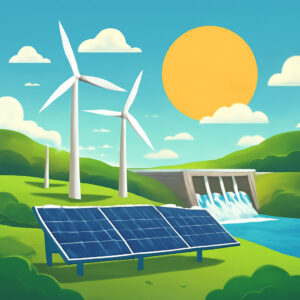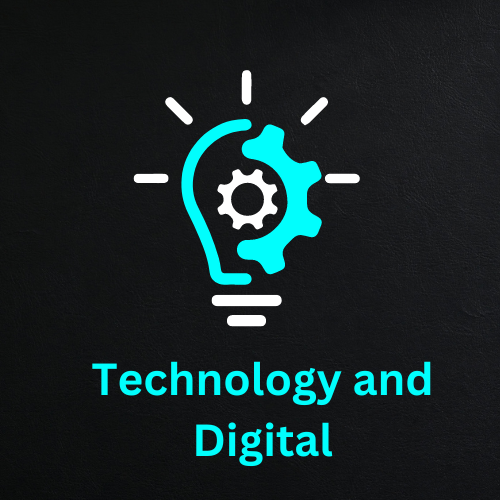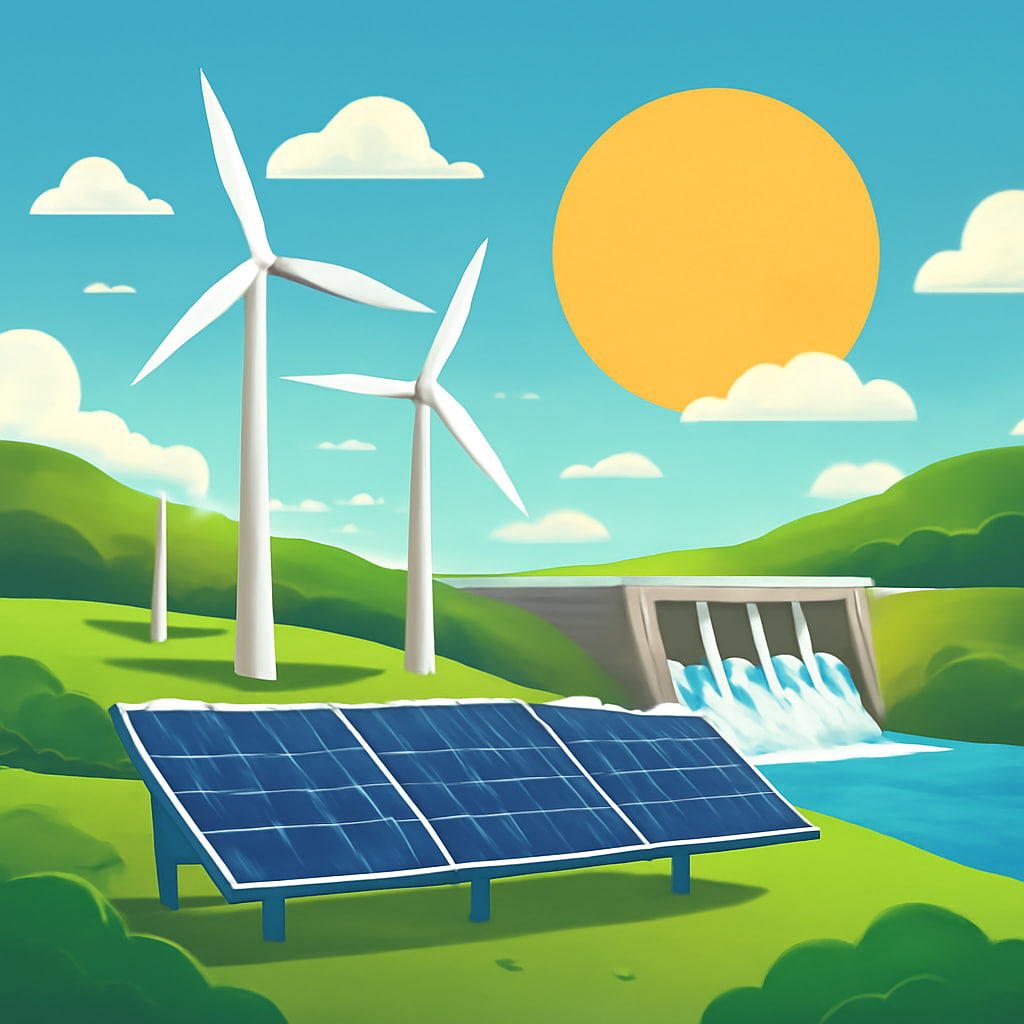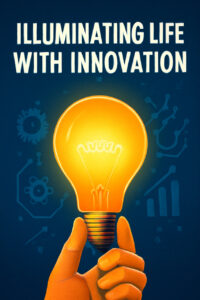The Future of Renewable Energy: Powering a Sustainable Tomorrow

Across the world, a quiet revolution is taking place — one driven not by noise or chaos, but by the hum of clean power. The future of renewable energy is no longer a distant vision; it is here, unfolding in every wind turbine turning against the skyline and every solar panel reflecting the morning sun. As the global community faces the undeniable effects of climate change, the need for sustainable, renewable energy sources has evolved from an option to a necessity. The future of renewable energy represents not just technological progress, but a promise — a promise of hope, balance, and responsibility to the planet and future generations.
The Driving Force Behind Renewable Energy
Renewable energy refers to power generated from natural sources that are constantly replenished — such as sunlight, wind, rain, tides, and geothermal heat. Unlike fossil fuels, these energy sources do not run out and produce minimal environmental impact. Over the last decade, renewable technologies have advanced dramatically. According to the International Energy Agency (IEA), renewable energy sources are expected to supply over 42% of global electricity by 2030, an achievement driven by innovation, falling costs, and a collective global commitment to sustainability.
Behind this growth lies a simple truth: energy shapes every part of human life. From powering cities and industries to connecting people through digital networks, energy fuels progress. The shift toward renewable sources ensures that this progress doesn’t come at the cost of the environment.
Emerging Technologies Powering the Future
Innovation is the heartbeat of renewable energy. Every year brings breakthroughs that redefine what’s possible. For instance, solar energy has seen exponential growth with the development of high-efficiency photovoltaic cells. Modern solar panels now convert more sunlight into power using less space, making them ideal for urban environments.
Wind power continues to soar as well, with offshore wind farms becoming key contributors to national grids. Floating wind turbines, capable of being installed in deeper waters, are opening new frontiers for coastal nations. Meanwhile, hydrogen energy — particularly green hydrogen produced from renewable sources — is gaining traction as a clean alternative to fossil fuels in industries and heavy transport.
Another game-changing innovation is in energy storage. The intermittent nature of renewables has long been a challenge, but new battery technologies like solid-state and lithium-sulfur batteries promise to store energy more efficiently and safely. With these advances, renewable energy can become a reliable 24/7 power source, even when the sun isn’t shining or the wind isn’t blowing.
Practical Tip for Communities and Businesses
For organizations and communities seeking to embrace renewables, the best starting point is energy auditing. By understanding current energy consumption, it becomes easier to identify where renewable integration — such as solar rooftops or microgrids — can make the most impact. Small changes often lead to significant long-term benefits, both financially and environmentally.
The Role of Digital Transformation in Renewable Energy
Information technology is playing an increasingly vital role in optimizing renewable energy systems. Through data analytics, artificial intelligence, and the Internet of Things (IoT), energy providers can monitor and adjust production in real time. For example, smart grids use sensors and automation to balance electricity supply and demand more efficiently, reducing waste and ensuring stability even during high-consumption periods.
Artificial intelligence helps forecast energy production by analyzing weather patterns and historical data, enabling operators to plan better. Meanwhile, blockchain technology is introducing transparency and traceability in energy trading, allowing consumers to buy renewable power directly from producers. These digital advancements represent a merging of sustainability and technology, proving that innovation and environmental care can go hand in hand.
Global Momentum and Green Policies
The rise of renewable energy has been accelerated by bold policy decisions worldwide. Nations are setting ambitious carbon-neutral goals, with countries like Germany, Japan, and Canada investing billions in renewable infrastructure. In 2024, the European Union reported that renewable energy accounted for more than 55% of its electricity mix, showcasing how collective policy, investment, and innovation can drive meaningful change.
Developing nations are also embracing renewables as a pathway to independence. In regions of Africa and Southeast Asia, decentralized solar microgrids are bringing electricity to rural areas for the first time, improving healthcare, education, and local economies. The emotional impact of seeing a village illuminated by clean energy for the first time is a reminder that renewable energy is not just about efficiency — it’s about empowerment.
Practical Tip for Policymakers
To sustain momentum, policymakers must focus on public-private partnerships and community-based energy projects. Encouraging local participation ensures that renewable initiatives are not only technologically sound but socially inclusive. Awareness programs and education campaigns can also help citizens understand the personal benefits of adopting clean energy at home and in business.
Challenges on the Road Ahead
Despite its promise, the path toward a fully renewable world is not without challenges. Infrastructure limitations, high initial costs, and storage constraints remain key obstacles. Furthermore, political and economic instability in some regions slows the adoption of long-term sustainability strategies.
However, history has shown that every technological revolution faces resistance before acceptance. The renewable energy movement is following the same curve — progressing through innovation, investment, and public awareness. As technology becomes more affordable and accessible, these barriers will continue to fall.
The Emotional Power of Change
Renewable energy is more than technology — it is a reflection of humanity’s desire to do better. It speaks to compassion, responsibility, and vision. The sight of a solar-powered school, a wind farm turning on a hill, or a city running on clean energy evokes not just pride but hope. Hope that the world can live in harmony with nature without sacrificing progress. Hope that innovation can serve life rather than deplete it.
The emotional connection between people and the planet is what makes renewable energy more than an industrial trend — it makes it a moral movement. Every action taken today, no matter how small, contributes to a collective legacy of sustainability.
Conclusion: Lighting the Way Forward
The future of renewable energy stands as a beacon for a sustainable and equitable world. Its growth is transforming industries, inspiring innovation, and empowering communities. It challenges humanity to think differently — to value the planet not as a resource to be consumed, but as a home to be protected.
As the world steps further into the digital age, renewable energy will form the foundation of progress. The choices made today will determine the quality of life for generations to come. From wind farms that dance with the breeze to solar panels that soak up the sun’s endless gift, renewable energy represents more than power — it represents possibility.
What’s your vision for a renewable-powered future? Share your thoughts below and join the global conversation on how technology and sustainability can shape a brighter, greener tomorrow.




